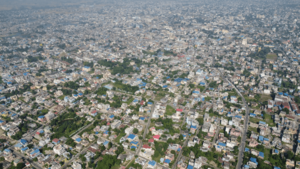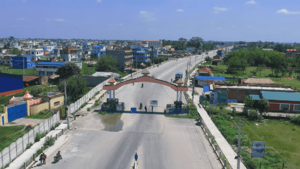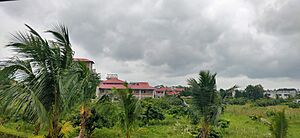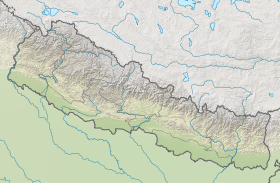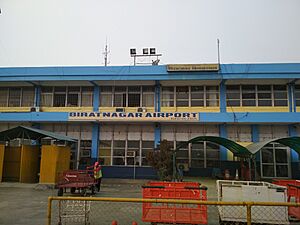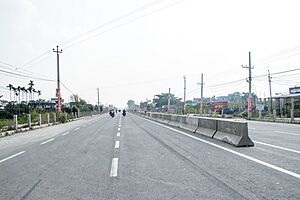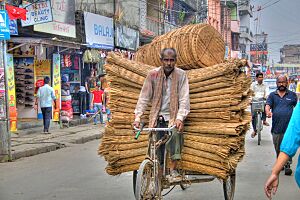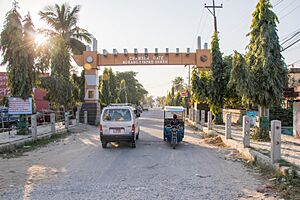Biratnagar facts for kids
Quick facts for kids
Biratnagar
विराटनगर
|
|
|---|---|
| Biratnagar Metropolitan City | |
|
From top, left to right: Biratnagar Gate, Biratnagar industrial skyline, Biratnagar market skyline, Greenery panorama seen from Biratnagar Eye Hospital
|
|
| Nicknames:
Capital of Nepal
|
|
| Country | |
| Province | Koshi |
| District | Morang |
| Incorporated | 1914 (as district headquarters) |
| Upgraded to metropolitan city | 2017 |
| Wards | 19 |
| Government | |
| • Type | Mayor-council |
| • Body | Biratnagar Metropolitan City Council |
| Area | |
| • Total | 77 km2 (30 sq mi) |
| Elevation | 80 m (260 ft) |
| Population
(2021)
|
|
| • Total | 244,750 |
| • Rank | 6th (Nepal) 1st (Koshi Province) |
| • Density | 3,179/km2 (8,230/sq mi) |
| Languages | |
| • Official | Nepali |
| • Regional | Maithili |
| Time zone | UTC+5:45 (NST) |
| Postal code |
56613
|
| Area code(s) | 021 |
Biratnagar (Nepali: विराटनगर) is a large city in Nepal. It is the capital of Koshi Province. With a population of over 244,000 people, it is the biggest and fastest-growing city in the province. It is also the main city of Morang District.
Biratnagar is about 399 kilometres (248 mi) east of Kathmandu, Nepal's capital. It is also just 6 km (3.7 mi) north of Jogbani, a town in India. This makes Biratnagar an important entry point for business people and tourists visiting Nepal. It became a metropolitan city on May 22, 2017. Biratnagar is the sixth largest city in Nepal.
This city is home to many factories, including the Biratnagar Jute Mills, which was Nepal's very first big factory. Biratnagar is known as the industrial capital of Nepal. It has also played a big part in Nepal's journey to democracy. Five former prime ministers of democratic Nepal were born here. The first ever labor strike that helped start the anti-Rana movement began in Biratnagar.
Today, Biratnagar is a key gateway to eastern Nepal and northeastern India. It is one of only two cities in Nepal with a railway connection to India. It also has an Integrated Check Post (ICP) at the Indian border, which helps with trade and travel.
Contents
- Who are the Mayors of Biratnagar?
- What is the History of Biratnagar?
- What is the Climate like in Biratnagar?
- What is the Population of Biratnagar?
- How to Travel in and out of Biratnagar?
- What is the Economy of Biratnagar like?
- What are the Tourist Attractions in Biratnagar?
- What are the Educational Opportunities in Biratnagar?
- Art and Literature in Biratnagar
- What Sports are Popular in Biratnagar?
- Notable People from Biratnagar
- See also
Who are the Mayors of Biratnagar?
A mayor is the leader of a city government. They help make decisions for the city and its people. Here are the recent mayors of Biratnagar:
| Election Year | Mayor | Party | Term | |
|---|---|---|---|---|
| 2074 BS (2017 AD) | Bhim Parajuli | Nepali Congress | 2074-2079 BS (2017-2022 AD) | |
| 2079 BS (2022 AD) | Nagesh Koirala | Nepali Congress | 2079-2084 BS (2022-2027 AD) | |
What is the History of Biratnagar?
The modern city of Biratnagar started in 1914. A district governor named Colonel Jit Bahadur Khatri moved important offices like the hospital and post office to Gograha Bazaar. This area later became Biratnagar.
The history of this region goes back to the 7th century. King Mung Mawrong Hang ruled the area and built a town east of present-day Biratnagar. He named his kingdom Morang.
The old name of Biratnagar was Gograha Bazaar. You can still find old ruins of temples and palaces south of the city in Vedhyari, Buddhanagar.
The town was officially named Biratnagar in 1919. The name came from old ruins found there, which people thought might belong to King Virata. In Nepali, Birat means "King Virata" and Nagar means "City". So, Biratnagar means "King Virata's City".
Biratnagar played a big role in Nepal's history. On March 4, 1947, the first protest against the Rana rulers began at the Biratnagar jute mills. This protest, led by Girija Prasad Koirala and B. P. Koirala, helped start a country-wide movement that eventually ended the Rana family's rule in Nepal.
What is the Climate like in Biratnagar?
Biratnagar has a warm climate. The highest temperature ever recorded was 43.0 °C (109.4 °F) in April 1992. The lowest temperature was −1.0 °C (30.2 °F) in December 1970 and January 1971.
| Climate data for Biratnagar (1991–2020) | |||||||||||||
|---|---|---|---|---|---|---|---|---|---|---|---|---|---|
| Month | Jan | Feb | Mar | Apr | May | Jun | Jul | Aug | Sep | Oct | Nov | Dec | Year |
| Mean daily maximum °C (°F) | 22.3 (72.1) |
26.3 (79.3) |
31.1 (88.0) |
33.9 (93.0) |
33.6 (92.5) |
33.1 (91.6) |
32.6 (90.7) |
33.0 (91.4) |
32.6 (90.7) |
31.9 (89.4) |
29.5 (85.1) |
25.3 (77.5) |
30.4 (86.7) |
| Daily mean °C (°F) | 15.8 (60.4) |
18.9 (66.0) |
23.5 (74.3) |
27.4 (81.3) |
28.6 (83.5) |
29.2 (84.6) |
29.3 (84.7) |
29.5 (85.1) |
28.8 (83.8) |
26.7 (80.1) |
22.5 (72.5) |
18.1 (64.6) |
24.9 (76.8) |
| Mean daily minimum °C (°F) | 9.2 (48.6) |
11.5 (52.7) |
15.9 (60.6) |
20.8 (69.4) |
23.5 (74.3) |
25.3 (77.5) |
25.9 (78.6) |
26.0 (78.8) |
25.0 (77.0) |
21.4 (70.5) |
15.5 (59.9) |
10.9 (51.6) |
19.2 (66.6) |
| Average precipitation mm (inches) | 11.1 (0.44) |
11.0 (0.43) |
16.8 (0.66) |
58.8 (2.31) |
172.0 (6.77) |
306.2 (12.06) |
475.6 (18.72) |
353.1 (13.90) |
269.1 (10.59) |
75.7 (2.98) |
3.8 (0.15) |
4.3 (0.17) |
1,757.5 (69.19) |
| Average precipitation days (≥ 1.0 mm) | 1.2 | 1.5 | 1.8 | 4.5 | 9.9 | 15.1 | 18.8 | 16.3 | 13.5 | 3.7 | 0.4 | 0.5 | 87.1 |
| Source: World Meteorological Organization | |||||||||||||
What is the Population of Biratnagar?
Biratnagar is a diverse city with many different languages and cultures.
Languages Spoken
In 2011, the most common languages spoken in Biratnagar were Maithili (39.4%) and Nepali (38.3%). Other languages include Urdu, Rajasthani, and Tharu.
Languages in Biratnagar Maithili (39%) Nepali (38%) Urdu (5%) Rajasthani (2%) Others (16%)
Religions in Biratnagar
Most people in Biratnagar follow Hinduism. There are also many followers of Islam, Buddhism, and other religions.
| Religion in Biratnagar (2011) | ||||
|---|---|---|---|---|
| Religion | Percent | |||
| Hinduism | 89% | |||
| Islam | 8% | |||
| Others | 2% | |||
Ethnic Groups
Biratnagar is home to many different ethnic groups. Some of the largest groups include Hill Brahmin, Chhetri, Musalman, Yadav, and Newar.
How to Travel in and out of Biratnagar?
Biratnagar has good transport links, making it easy to travel around.
Air Travel
Biratnagar Airport is an important airport for eastern Nepal. Many flights go to Kathmandu every day, making it one of the busiest domestic airports in Nepal.
Road Travel
Biratnagar is about 544 kilometres (340 mi) by road from Kathmandu. It is well connected by bus to other cities in Koshi Province like Dharan and Itahari. You can also take buses to other parts of Nepal. The border point with India, Kakarbhitta, is about 108 km (67 mi) away.
Train Travel
You can take trains from Indian cities like Katihar and New Delhi to Jogbani, which is a town on the Indian side of the border. Biratnagar is only 7 km (4 mi) north of Jogbani. There is a customs checkpoint called Rani Bhansar for goods. People from India and Nepal can cross the border freely. There are also plans to build a monorail system in Biratnagar.
Getting Around the City
Inside Biratnagar, you can use bicycles, motor vehicles, rickshaws, and taxis. Auto rickshaws (Tempos) are good for longer distances. Electric rickshaws, also called City Safari, are very popular. They connect all parts of Biratnagar and are cheap and good for the environment.
What is the Economy of Biratnagar like?
Biratnagar is the main economic center of eastern Nepal. The first industry in Nepal, the Biratnagar jute mills, was started here. The city has a growing number of new businesses. The Golchha Organisation, a big business group, also started as a small business in Biratnagar. The city is important for trade with India because it has a major customs route and the second-largest land port in Nepal.
What are the Tourist Attractions in Biratnagar?
Biratnagar is a great starting point for exploring eastern Nepal. You can visit places like Ilam, known for its tea gardens, and Taplejung.
- Local Markets: Many colorful haat bazaars (weekly markets) are held in different parts of the town. Farmers sell fresh produce, spices, and handicrafts there.
- Gardens and Temples: Biratnagar has several beautiful gardens, like Gopal Garden and Hridreyandra Bal Udhhyan. The city's temples are also very attractive and decorated with bright colors.
- Nearby Places:
* Dharan (46 km (30 mi)) and Itahari (24 km (10 mi)) are north of Biratnagar. They have places like Taltalaiya, Ocean Park, and famous temples such as Dantakali Temple and Budha Subba Temple. * Bhedetar is a hill-station nearby with great views. * The tea gardens of Ilam are about a 4-hour drive away. * Dhankuta is a hilly area famous for its orange orchards. * The Koshi Tappu Wildlife Reserve is a 90-minute drive away. It's a great place for bird-watching and home to the endangered wild buffaloes called "Arna". * You can also visit the largest rhododendron forests of Tinjure, Milke, and Jaljale, which are about 3-4 hours away.
What are the Educational Opportunities in Biratnagar?
Biratnagar is a major center for education in eastern Nepal. It has many schools, colleges, and universities.
Universities
- Purbanchal University
- Bright Vision Law College (affiliated with Purbanchal University)
Engineering Colleges
- Purbanchal University School of Engineering
- Eastern College of Engineering
Medical Colleges
- Birat Medical College
- Nobel Medical College
- Khoshi Health Institution
Forestry College
- Purbanchal University College of Environment and Forestry
Schools
- Bal Kalyan Bidhya Mandir (B.K.V.M) Boarding School
- Adarsha Secondary School
- Everest Secondary School
- Sagarmatha School
- Birat Shiksha Niketan School
- Arniko School
- Janpath School
- Arpan School
- Lord Buddha Niketan
- Shree Radha Krishna Bhupal Man Singh Karki School
- Modern Era School
- Shree Satyanarayan Secondary School
Most private schools, colleges, and universities teach in English. Government schools teach in Nepali up to secondary level. Biratnagar has over 80 schools, more than 20 colleges, and 21 hospitals, which is a lot for a city in Nepal, second only to Kathmandu.
Art and Literature in Biratnagar
Biratnagar has been a home for many famous writers and artists. Important Nepali books, like Bholi Basne Bihan by Krishna Bhooshan Bal and Jeevanko Chheubaata by Suman Pokhrel, were first published here. People in Biratnagar often gather for poetry readings.
The famous theater group, Aarohan Gurukul, was started in Biratnagar in 1982. This group has created many plays, including Agniko Katha and Yajnaseni, and performed them across the country. Today, Aarohan Gurukul is a popular place to visit in Biratnagar.
What Sports are Popular in Biratnagar?
Cricket and football are the most popular sports in Biratnagar. Biratnagar City F.C. is a well-known football club in the city.
- Sahid Rangsala: This is the largest football stadium in Biratnagar, with space for over 15,000 fans. It is the home stadium for Morang Football Club. The Birat Gold Cup, a big football tournament, is held here.
- Other Facilities: There is a covered hall near Sahid Maidan for indoor sports. A new cricket stadium is being built in Baijanathpur to host local and national cricket games. The city also has courts for lawn tennis and basketball.
Notable People from Biratnagar
Many famous people have come from Biratnagar, including:
Medical Professionals
- Bhola Rijal, a famous doctor specializing in women's health, who is also a poet.
Actors, Actresses, and Comedians
- Sushila Koirala; a classical dancer and theater director.
- Suman Pokhrel, a poet, lyricist, and playwright.
- Sunil Pokhrel, an actor.
- Shilpa Maskey, an actress.
- Shiv Shrestha, an actor.
- Ranu Devi Adhikari, a singer.
- Deepa Shree Niraula, an actress.
- Arunima Lamsal, an actress.
Sports People
- Siddhant Lohani, a cricketer.
- Lalit Narayan Rajbanshi, a cricketer for the Nepal cricket team.
- Bhola Silwal, a footballer.
See also
 In Spanish: Biratnagar para niños
In Spanish: Biratnagar para niños


